
The powertrain control module (PCM) is a precision 32-bit microprocessor and
is an essential part of the electronic control system. The PCM is responsible for
such major functions as control of the fuel injectors, the idle air control (IAC)
valve, the fuel pump relay, etc. The PCM (1) is located below the instrument panel
(IP) storage compartment. Communication with the PCM is through the data link connector
(2) located on the left side below the IP.
The PCM performs the OBD II diagnostic tests of the emission related
systems. The PCM supplies a buffered voltage, called reference voltage, to the various
information sensors and switches. The PCM controls most components with an electronic
switch that completes a ground circuit when turned ON. The electronic switch is commonly
referred to as an output driver. The PCM is also responsible for a self-diagnosis
function and a fail-safe function.
Self-Diagnosis Function
The powertrain control module (PCM) diagnoses any troubles which may occur in
the engine control system when the ignition switch is in the ON position with the
engine running. The PCM indicates a malfunction by illuminating the malfunction indicator
lamp (MIL) when a fault occurs in any of the following systems:
| • | The heated oxygen sensor 1 (HO2S 1) |
| • | The heated oxygen sensor 2 (HO2S 2) |
| • | The engine coolant temperature (ECT) sensor |
| • | The accelerator pedal position (APP) sensors |
| • | The throttle position (TP) sensors |
| • | The vehicle speed sensor (VSS) |
| • | The intake air temperature (IAT) sensor |
| • | The mass air flow (MAF) sensor |
| • | The camshaft position (CMP) sensor |
| • | The crankshaft position (CKP) sensor |
| • | The knock sensor (KS) system |
| • | The evaporative emission (EVAP) control system |
| • | The idle air control (IAC) system |
| • | The electronic throttle control (ETC) or throttle actuator control (TAC)
system |
| • | The CMP actuator solenoid system |
| • | The central processing unit (CPU) of the PCM |
When the PCM detects a malfunction in one of the above areas, the PCM will illuminate
or flash the MIL in order to notify the driver of the occurrence of a fault.
Malfunction Indicator Lamp (MIL) Operation
The malfunction indicator lamp (MIL) is located in the instrument panel
cluster. The MIL will display as either SERVICE ENGINE SOON or one of
the following symbols when commanded ON:
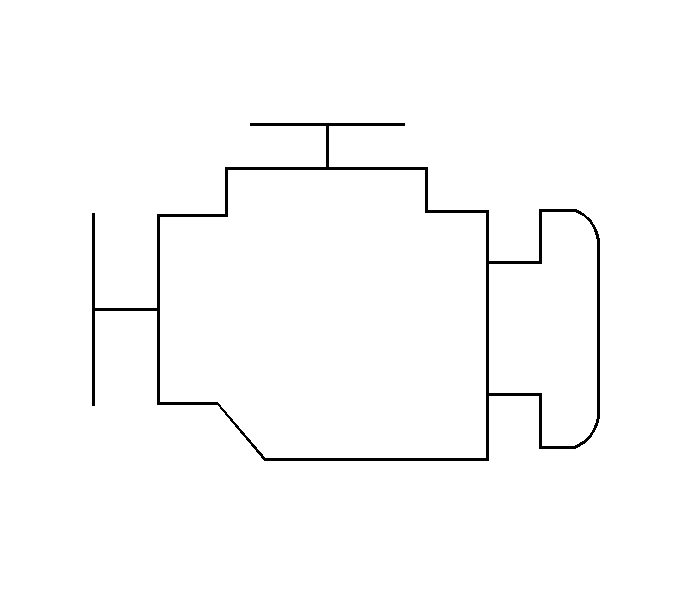
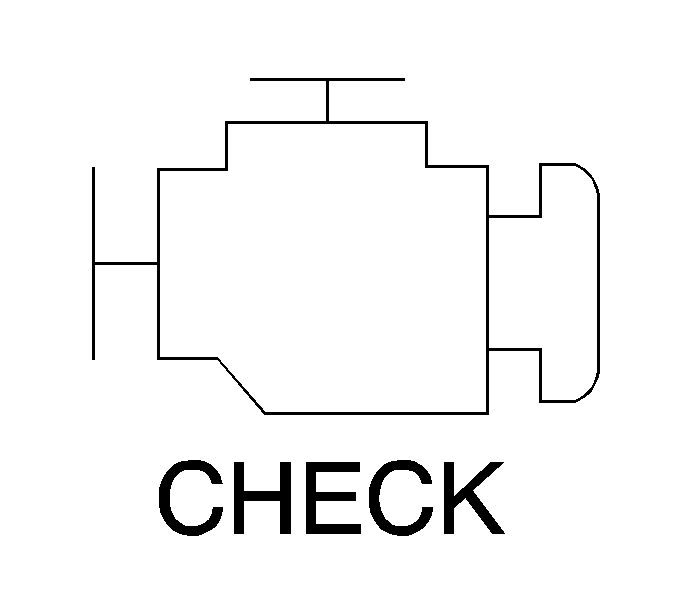
The MIL indicates that an emissions related fault has occurred
and vehicle service is required.
The following is a list of the modes of operation for the MIL:
| • | The MIL illuminates when the ignition is turned ON, with the engine
OFF. This is a bulb test to ensure the MIL is able to illuminate. |
| • | The MIL turns OFF after the engine is started if a diagnostic
fault is not present. |
| • | The MIL remains illuminated after the engine is started if the
control module detects a fault. A diagnostic trouble code (DTC) is stored
any time the control module illuminates the MIL due to an emissions
related fault. The MIL turns OFF after three consecutive ignition
cycles in which a Test Passed has been reported for the diagnostic
test that originally caused the MIL to illuminate. |
| • | The MIL flashes if the control module detects a misfire condition
which could damage the catalytic converter. |
| • | When the MIL is illuminated and the engine stalls, the MIL will
remain illuminated as long as the ignition is ON. |
| • | When the MIL is not illuminated and the engine stalls, the MIL
will not illuminate until the ignition is cycled OFF and then ON. |
Fail-Safe Function
When a malfunction occurs within the engine control system, the PCM maintains
control over the fuel injection system, the idle speed control system, etc. The PCM
controls these systems by using calculated values and/or backup programs stored within
the PCM.
This function is called the fail-safe function. With the fail-safe function,
a certain level of engine performance is available even when a malfunction occurs.
The fail-safe function prevents a complete loss of engine performance.
The systems covered by the fail-safe function are as follows:
| • | The HO2S heater circuits |
| • | The fuel cut-off for ignition system failures |
Control Module Learning Ability
The powertrain control module has a "learning" ability which enables
the control module to make corrections for minor variations in the fuel system. This
learning ability can improve driveability. Disconnecting the battery resets the learning
process. A change in the vehicle's performance may be noticed when a reset from a
PCM power down occurs. Operating the vehicle under varying conditions will enable
the control module to regain any lost vehicle performance.
In order to initiate the control module learning ability, warm the engine to
operating temperature and drive the vehicle at part throttle with moderate acceleration.
Continue to drive the vehicle while including steady cruise and idle speed operation.
For the best idle speed quality several key cycles with a short drive and long idle
periods is recommended.
Check Mode
The PCM has the ability to operate in the Normal mode or in the Check Mode.The
2 modes of operation are similar. When the PCM is operating in the Check mode, the
PCM has an increased ability to detect malfunctions. The most significant feature
of the Check mode operation is that all B type codes now run like A type codes. In
order to request that the PCM operate in the Check Mode, scan tool communication with
the PCM is necessary. For information on the use of the Check Mode in diagnosing driveability
concerns, refer to
Service Bay Test.
PCM Output Controls
The powertrain control module (PCM) can be directed by a scan tool to operate
certain solenoids, valves, motors, and switches. This scan tool function is generally
referred to as Output Controls. The Output Controls can be found under Special Functions
selection of the scan tool. Some Output Controls may be disabled by the PCM during
certain types of vehicle operation. Operating a PCM controlled device with the scan
tool should be limited to a maximum of ten seconds per test period.
Data Link Connector (DLC)
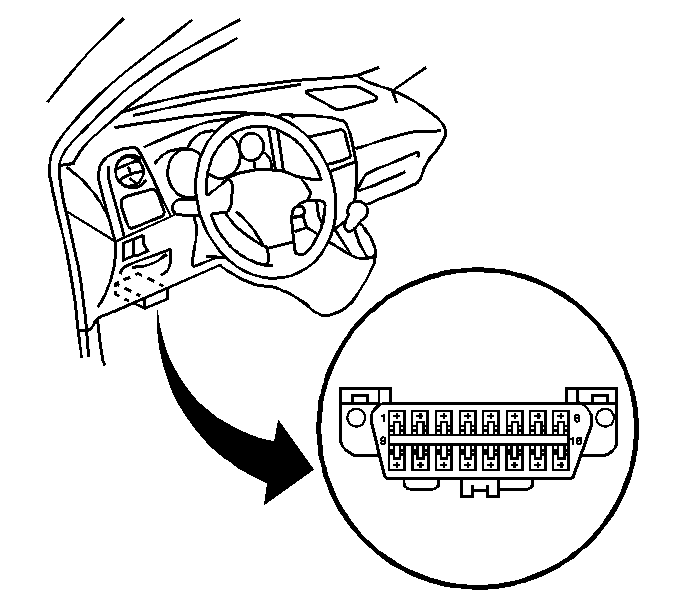
Important: Do not use a scan tool that displays faulty data. Report the scan tool problem
to the manufacturer. Use of a faulty scan tool can result in misdiagnosis and unnecessary
parts replacement.
The provision for communicating with the control module is the data link connector
(DLC). The DLC is located under the instrument panel to the left of the steering column.
The DLC is used to connect to a scan tool. Some common uses of the scan tool are listed
below:
| • | Identifying stored diagnostic trouble codes (DTCs) |
| • | Performing output control tests |
| • | Reading the serial data |
Reading Diagnostic Trouble Codes
The procedure for reading diagnostic trouble codes is to use a diagnostic scan
tool. Follow the instructions supplied by the scan tool manufacturer in order to read
DTCs accurately.
Clearing Diagnostic Trouble Codes
Important: Do not clear the DTCs unless directed to do so by the service information provided
for each diagnostic procedure. The Freeze Frame data which may help diagnose an intermittent
fault will be erased from the memory when the DTCs are cleared.
The PCM will begin to count the warm-up cycles when the fault that caused the
DTC to be stored into memory has been corrected. The DTC will automatically be cleared
from the PCM memory when the PCM has counted 40 consecutive warm-up cycles with no
further faults detected.
Diagnostic trouble codes (DTCs) can be cleared using a scan tool. In order to
clear DTCs, use the scan tools Clear DTC Information function. Follow the instructions
supplied by the scan tool manufacturer.
Aftermarket (Add-On) Electrical and Vacuum Equipment
Notice: Connect any add-on electrically operated equipment to the vehicle's
electrical system at the battery (power and ground) in order to prevent damage
to the vehicle.
Notice: Do not attach add-on vacuum operated equipment to this vehicle. The
use of add-on vacuum equipment may result in damage to vehicle components
or systems.
Aftermarket (add-on) electrical and vacuum equipment is defined as any equipment
installed on a vehicle after leaving the factory that connects to the vehicles electrical
or vacuum systems. No allowances have been made in the vehicle design for addition
of this type of equipment.
Add-on electrical equipment may cause the engine control system to malfunction
even when the add-on electrical equipment is installed properly. Portable telephones
and radios may also cause engine control system malfunctions even when not connected
to the vehicles electrical system. The first step in diagnosing any engine control
system problem is to remove all aftermarket electrical equipment from the vehicle.
Diagnosis may proceed in the normal manner after eliminating aftermarket equipment
as a cause of the engine control system malfunction.
Electrostatic Discharge (ESD) Damage
Notice: In order to prevent possible Electrostatic Discharge damage to the PCM,
Do Not touch the connector pins or the soldered components on the circuit
board.
Electronic components used in the engine control system are often designed to
operate at very low voltages. Electronic components are susceptible to damage caused
by electrostatic discharge. Less than 100 volts of static electricity can cause
damage to some of the electronic components. There are several ways for a person to
become statically charged. The most common methods of charging are by friction and
by induction. An example of charging by friction is a person sliding across a car
seat. Charging by induction occurs when a person with well insulated shoes stands
near a highly charged object and momentarily touches ground. Charges of the same polarity
are drained off leaving the person highly charged with the opposite polarity. Therefore,
use care when handling and testing electronic components in order to avoid electrostatic
charges that can cause electronic component damage.
Input Components
The PCM supplies a buffered (reference) voltage to the various information sensors
and switches. The PCM monitors the input components for circuit continuity and out-of-range
values. The PCM also provides performance checking. Performance checking refers to
the PCM indicating a fault when the signal from an input does not seem reasonable,
i.e., a throttle position (TP) sensor that indicates a high throttle position at low
engine loads or low manifold absolute pressure sensor voltage. The input components
may include, but are not limited to the following sensors and switches:
| • | The crankshaft position (CKP) sensor |
| • | The accelerator pedal position (APP) sensors |
| • | The throttle position (TP) sensors |
| • | The engine coolant temperature (ECT) sensor |
| • | The camshaft position (CMP) sensor |
| • | The mass air flow (MAF) sensor |
| • | The heated oxygen sensor (HO2S) |
| • | The fuel tank pressure (FTP) sensor |
| • | The vehicle speed sensor (VSS) |
| • | The power steering pressure (PSP) switch, if equipped |
| • | The transmission range switch (A/T only) |
| • | The A/C compressor control module (A/C relay) |
Output Components
The PCM is responsible for the control and operation of many output components.
The PCM controls many components with an electronic switch called an output driver
that completes a ground circuit when turned ON. The PCM monitors the output components
for the proper response to the PCM commands. Components where functional monitoring
is not feasible will be monitored for circuit continuity and out-of-range values if
applicable.
Output components to be monitored include, but are not limited to the following
circuits:
| • | The idle air control (IAC) valve |
| • | The CMP actuator solenoid valve |
| • | The circuit opening or fuel pump relay |
| • | The EVAP system solenoids |
| • | The EVAP vacuum leak pump |
| • | The malfunction indicator lamp (MIL) control |
| • | The A/C compressor control module (A/C relay) |
| • | The electronic transaxle controls |
Catalyst Monitor Diagnostic Operation
The powertrain control module (PCM) uses certain diagnostic strategies known
as primary system based diagnostics that evaluate the various primary system operations.
The primary system based diagnostics also evaluate the various primary system operations
affect on vehicle emissions. Some of the primary system based diagnostics are listed
here with a brief functional description of the diagnostics involved.
The OBD 2 catalyst monitor diagnostic measures the oxygen storage capacity of
the 3-way catalytic converter (TWC). Heated oxygen sensors (HO2S) are installed before
(pre-catalyst) and after (post-catalyst) the TWC. Voltage variations between the sensors
allow the PCM to determine the performance of the TWC catalyst. When the TWC catalyst
becomes less effective in promoting chemical reactions, the catalyst's capacity to
store and release oxygen is generally degraded. The OBD 2 catalyst monitor diagnostic
is based on a correlation between the conversion efficiency of the TWC catalyst and
the oxygen storage capacity of the catalyst. A good catalyst, e.g., 95 percent
hydrocarbon conversion efficiency, will show a relatively flat output voltage on the
post-catalyst sensor, HO2S 2. A degraded catalyst, 65 percent hydrocarbon
conversion, will show greatly increased activity in the output voltage from the post
catalyst HO2S.
The post-catalyst HO2S is used to measure the oxygen storage and release capacity
of the catalyst in the TWC. A high oxygen storage capacity indicates a good catalyst.
A low oxygen storage capacity indicates a failing catalyst. The TWC and the HO2S 2
must be at operating temperature in order to achieve the correct oxygen sensor voltages,
like those shown in the post-catalyst HO2S Outputs graphic.
The catalyst monitor diagnostic is sensitive to the following conditions:
Exhaust system leaks may cause any of the following results:
| • | A false failure for a normally functioning, good catalyst. |
| • | Prevent a degraded catalyst from failing the catalyst monitor diagnostic. |
| • | Prevent the catalyst monitor diagnostic from running. |
The presence of HO2S contaminants may prevent the catalyst monitor diagnostic
from functioning properly.
Three-Way Catalyst Oxygen Storage Capacity
The TWC catalyst must be monitored for efficiency. In order to accomplish this,
the control module monitors the pre-catalyst (HO2S 1) and post-catalyst (HO2S 2)
oxygen sensors. When the TWC is operating properly, the post-catalyst oxygen sensor
will have significantly less activity than the pre-catalyst oxygen sensor. The TWC
stores and releases oxygen as needed during the normal reduction and oxidation process.
The control module will calculate the oxygen storage capacity using the difference
between the pre-catalyst and post-catalyst oxygen sensor voltage levels. If the activity
of the post-catalyst oxygen sensor approaches that of the pre-catalyst oxygen sensor,
the catalyst's efficiency is degraded.
Stepped or staged testing levels allow the PCM to statistically filter test
information. This prevents falsely passing or falsely failing the catalyst monitor
oxygen storage capacity test. The calculations performed by the on-board diagnostic
system are very complex. Post-catalyst oxygen sensor activity should not be used to
determine the oxygen storage capacity unless directed by the service manual.
A 2-stage test is used to monitor the catalyst efficiency. Failure of the first
stage of the test will indicate that the catalyst requires further testing in order
to determine the catalyst efficiency. The second stage test looks at the inputs from
the pre-catalyst and post-catalyst HO2S sensors more closely in order to determine
if the catalyst is actually degraded. This two stage test further increases the accuracy
of the oxygen storage capacity monitor. Failing the first stage test DOES NOT indicate
a failed catalyst. The catalyst may be marginal or the fuels sulfur content could
be very high.
Aftermarket HO2S characteristics may be significantly different from the original
equipment manufacturer HO2S. An inferior HO2S may lead to a false pass or a false
fail of the catalyst monitor diagnostic. An aftermarket catalytic converter that does
not contain the same amount of cerium as the original catalytic converter can cause
a false DTC to set. An incorrect amount of cerium in the catalyst can alter the correlation
between the oxygen storage and the conversion efficiency of the TWC.
Catalyst Monitor (Good Catalyst)
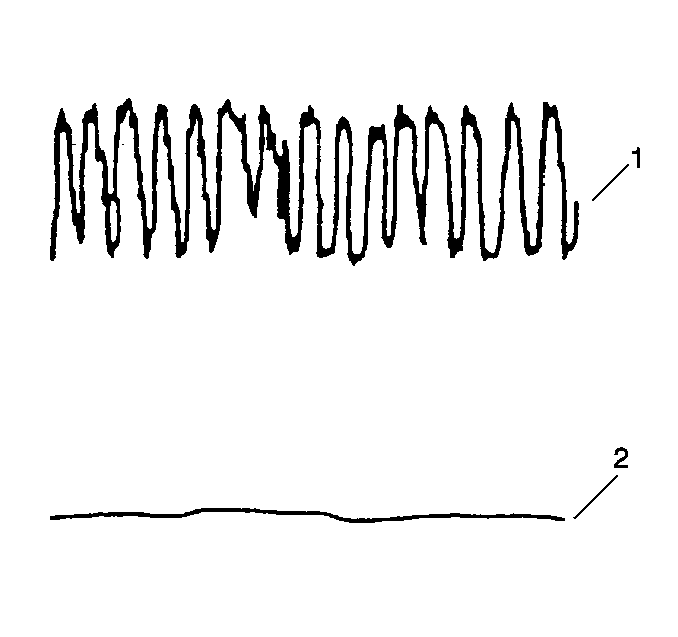
A good TWC catalyst will show a very active output voltage on the pre-catalyst
heated oxygen sensor (1). A good catalyst, 95 percent hydrocarbon conversion,
will show a relatively flat output voltage on the post-catalyst heated oxygen sensor (2).
Catalyst Monitor (Bad Catalyst)
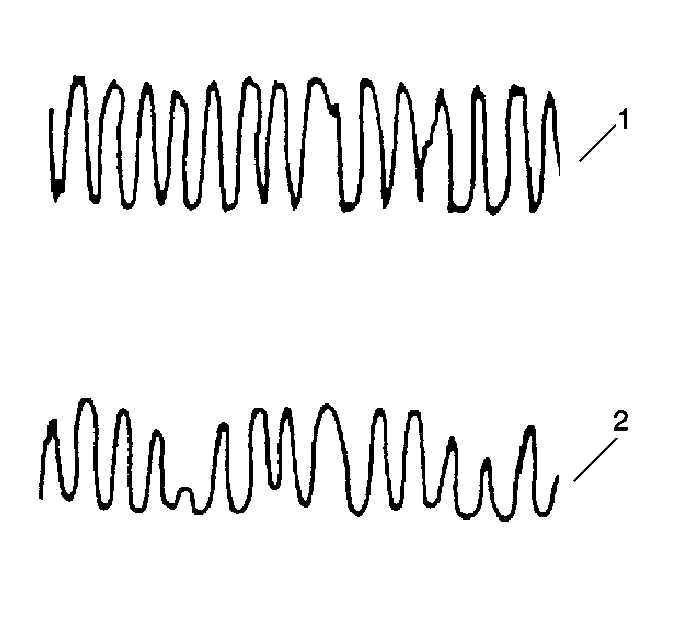
A degraded TWC catalyst, 65 percent hydrocarbon conversion, will show
greatly increased activity in the output voltage from the post-catalyst heated oxygen
sensor (2). The degraded catalyst post-catalyst HO2S output voltage will therefore
appear similar to the typically active output voltage of the pre-catalyst heated oxygen
sensor (1).
Misfire Monitor Diagnostic Operation
The misfire monitor diagnostic is based on crankshaft rotational velocity,
reference period, variations. The powertrain control module determines the crankshaft
rotational velocity using the crankshaft position sensor and the camshaft position
sensor. When a cylinder misfires the crankshaft actually slows down momentarily. By
monitoring the crankshaft and the camshaft position sensor signals, the control module
can calculate when a misfire occurs.
For a non-catalyst damaging misfire, the diagnostic will be required to report
a misfire that is present within 1000-3200 engine revolutions.
For a catalyst damaging misfire, the diagnostic will respond to a misfire that
is within 200 engine revolutions.
Rough roads may cause a false misfire detection. A rough road will cause torque
to be applied to the drive wheels and the drive train. This torque can intermittently
decrease the crankshaft rotational velocity and cause a false misfire detection.
On automatic transaxle equipped vehicles, the torque converter clutch (TCC)
will be disabled whenever a misfire is detected. Disabling the TCC isolates the engine
from the rest of the drive line and minimizes the effect of the drive wheel inputs
(torque) on the crankshaft rotation.
When the TCC has been disabled as a result of a misfire detection, the TCC will
be re-enabled after approximately 3200 engine revolutions with no misfire is detected.
The TCC will remain disabled whenever a misfire is detected. This allows the misfire
diagnostic to evaluate the system.
Fuel Trim System Monitor Diagnostic Operation
The fuel system monitor diagnostic averages of short-term and long-term fuel
trim values. If these fuel trim values stay at the fuel trim limits for a calibrated
period of time, a malfunction is indicated. The fuel trim diagnostic compares the
averages of the short-term fuel trim values and the long-term fuel trim values to
the rich and lean thresholds. If either value is within the thresholds, a pass is
recorded. If both values are outside the acceptable thresholds, a rich or lean DTC
will be recorded.
In order to meet OBD ll requirements, the control module uses weighted
fuel trim cells in order to determine the need to set a fuel trim DTC. A fuel trim
DTC can only be set if the fuel trim counts in the weighted fuel trim cells exceed
the specifications. A vehicle that has a fuel trim problem that is causing a concern
under certain conditions but operates fine under other conditions may not set a fuel
trim DTC. For example an engine that is idling high due to a small vacuum leak or
an engine that is running rough due to a large vacuum leak may set an idle speed DTC
or an HO2S DTC but not a fuel trim DTC.
A fuel trim DTC may be triggered by many different vehicle faults. Use all of
the diagnostic information available when diagnosing a fuel trim fault.






